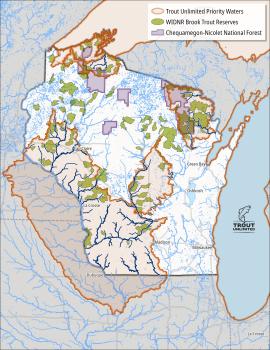Changes to the Great Lakes, fish and wildlife, natural resources and communities are expected due to future conditions such as extreme heat, more frequent droughts, warmer winters, declining lake ice extent and duration, rising water temperatures, and flooding. These stressors will cause damage to infrastructure and habitats, increased sediment and nutrient delivery to waters, increased harmful algal blooms, reduced beach health, increased pressure from non-native species and loss of culturally significant resources and recreational opportunities for communities. The Fifth National Climate Assessment documents these challenges in more detail, including how programs such as GLRI can meet these challenges through innovation and adaptation.
Under Action Plan IV, consideration of projected climate change impacts by agencies, Tribal Nations and other entities will be emphasized during the design and implementation of the next phase of GLRI projects. This approach builds upon national guidance to make much-needed changes to how we implement our programs and seek to better recognize disadvantaged and other communities with environmental justice concerns that face challenges and recovery from future climate changes (see the National Climate Resilience Framework, hereafter NCRF). Future GLRI investments will be closely aligned with the NCRF, advancing NCRF objectives to 1) embed climate into planning/ management and 2) protect and sustainably manage lands and water that provide benefits to our communities.
Climate Adaptation Approaches for GLRI Projects
Climate adaptation approaches consider future projected conditions, then increase the capacity of the environment to adapt, or take advantage of opportunities resulting from future conditions. These approaches also reduce the vulnerability of the environment to climate impacts. GLRI projects will consider climate adaptation approaches for future investments including:
- Existing regional, state and Tribal tools and climate adaptation plans and project menus that provide project strategies and tactics (such as Strategies for Adapting Great Lakes Coastal Ecosystems to Climate Change or Aanji-bimaadiziimagak o’ow aki).
- Vulnerability assessments that identify the greatest risks to species, habitat, working lands, infrastructure, communities or ecosystems from climate change impacts.
- Adjustment of project designs and plans to moderate harm or exploit beneficial opportunities. This approach may be "incremental", "transformative" or a "piloting" of innovative project features.
Finally, GLRI projects may include one or more of the following adaptation options:
Resistance: Actions that improve the defenses of a site or system against anticipated changes or directly defend against disturbance to maintain relatively unchanged conditions.
Resilience: Actions that increase the capacity of connected social, economic and ecological systems to cope with a climate change event, trend or disturbance, responding or reorganizing in ways that maintain their essential function, identity and structure. For GLRI, this would include communities, working lands, species or populations, adapting to changing conditions and withstanding and recovering from adverse conditions.
Transition: Adjustment to future expected climate and its effects. Actions or behaviors that reduce losses or enhance benefits of natural variations in extreme weather/climate events.
See the Fifth National Climate Assessment Glossary for additional definitions and concepts.
Continue reading about the Action Plan IV:


